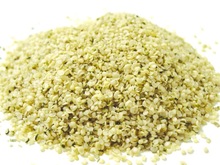Product of Canada
HS Code: 1207.99
Characterization: Dehulled hempseed
Sensory Profile: Small creamy nuts with little green specks and a light nutty flavor
Grain Purity: Hempseed cleaned to 99.95%
Application: Nutritious edible ingredient for baking, blends for mixes, butters or non-dairy beverages, Aspartic acid 3.59 snacks or as a toppingRequirements
Packaging: 50 lb (22.7 kg) bags, 2000 lb (907.2 kg) tote bags
Shelf Life: 14 months from the date of manufacturing
Storage Conditions Maintain in a cool dry environment away from oxidation, heat or sunlight. Humidity 30-50%
Hemp Seeds Health Benefit and History
Hemp seeds contain over 30% fat. They are exceptionally rich in two essential fatty acids, linoleic acid (omega-6) and alpha-linolenic acid (omega-3).
Hemp seeds are rich in healthy fats and essential fatty acids. They are also a great protein source and contain high amounts of vitamin E, phosphorus, potassium, sodium, magnesium, sulfur, calcium, iron and zinc.
They also contain gamma-linolenic acid, which has been linked with several health benefits.
Hemp seeds are a great protein source, as more than 25% of their total calories are from high-quality protein.
They contain high amounts of the amino acid arginine, which is used to produce nitric oxide in the body.
Hemp seeds are a great source of arginine and gamma-linolenic acid, which have been linked with a reduced risk of heart disease.
Hemp seeds are rich in healthy fats. They have a 3:1 ratio of omega-6 to omega-3, which may benefit skin diseases. In some cases, this may provide relief from eczema and its uncomfortable symptoms.
Whole hemp seeds are a good source of both soluble (20%) and insoluble (80%) fiber. Whole hemp seeds contain high amounts of fiber, which benefits digestive health.
Hemp seeds can be consumed raw, cooked or roasted. Hemp seed oil is also very healthy, and has been used as a food/medicine in China for at least 3,000 years
Commercial production (including cultivation) of industrial hemp has been permitted in Canada since 1998 under licenses and authorization issued by Health Canada (9,725 ha in 2004, 5450 ha in 2009).
In the early 1990s, industrial hemp agriculture in North America began with the Hemp Awareness Committee at the University of Manitoba. The Committee worked with the provincial government to get research and development assistance, and was able to obtain test plot permits from the Canadian government. Their efforts led to the legalization of industrial hemp.
In Canada the first Hemp harvest was in 1998. The cultivated area for hemp in the Prairie Provinces of Canada is stable at about 90,000 acres over 2013-15
25KG bags
1000kg bags
30 days shipping by ocian
15 days shipping available
























 在线聊天
在线聊天

























